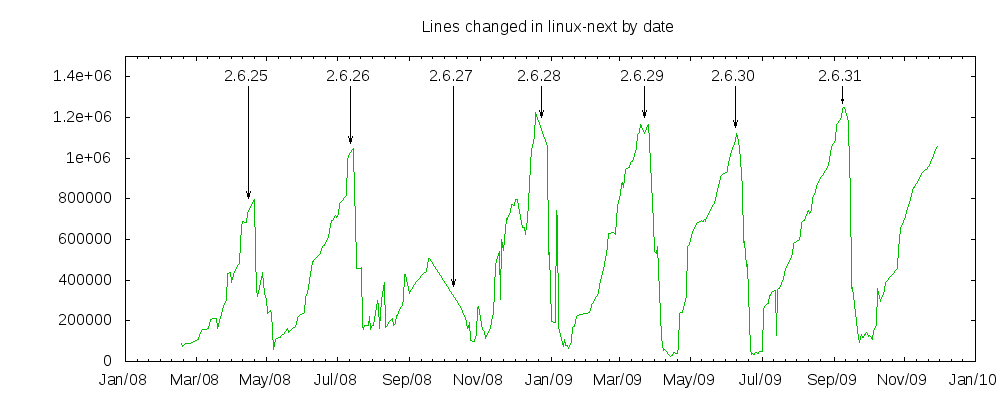Tue, 01 Dec 2009
Linux Next Graphing
A while back Rusty posted
about graphing
the size of the daily linux-next patches.
Since we are heading towards the merge window for 2.6.33 and
hence sfr has been
getting home later and later, I thought I'd take another look at it.
The dodgy script I've been using to create this is
out here.
This also creates the raw data file which
is here.
You can see some periods where there was no linux-next release, like
around the 2.6.27 release. You can also see that linux-next is never
zero size. Either Linus doesn't take everything in linux-next, or new
stuff for the following release is coming in before the last release
is done with. sfr mentioned that there is some stuff in linux-next
that's been in there for ages and hasn't been merged up to Linus.
There is a difference between how Rusty got his data and how I did.
Rusty used the size of
the bz2
patch out on kernel.org. These patches are against the release
and release candidates (ie. against 2.6.30, 2.6.30-rc1, 2.6.30-rc2,
etc). I'm using the linux-next git tree to determine how big
linux-next is for that day. Since sfr bases linux-next off Linus' git
origin each day, I take the difference between Linus' git origin and
the linux-next release to determine the size. Since Linus' origin is
at least as new as the RCs, my size is never larger than Rusty's.
This is especially noticeable in the merge window (the ~2 weeks
between the release and rc1). In the merge window, Rusty's size
continues to grow until rc1 is released, but mine starts to go down
almost immediately after the main release as Linus starts merging
trees into his git origin and making life easier for sfr. Also, Rusty
is using patch size (bz2 compressed) and I'm using the number of lines
changed (insertions + deletions).
It seems that maintainers are working/merging new code constantly
throughout the cycle. Ideally (yeah, coz I'm is the authority on
this!), we wouldn't see a lot of new code hit linux-next just
before the merge window opens as new code should hopefully be being
tested at this point. If the rate of new code was slowing down before
the merge window, we'd see the line flatten to horizontally before the
release. I guess we're hacking until the last minute, who would have
thought!?!? ;-)
The peaks of linux-next seem to be a reasonable predictor of the
relative size of the following kernel release. ie. if linux-next is
bigger, so is the following release, although it's not perfect (ie. 2.6.29
vs 32)
Release Actual line changes linux-next changes linux-next/Actual % 2.6.29 1879345 1222635 (peak at 2.6.28) 65% 2.6.30 1547035 1168031 (peak at 2.6.29) 76% 2.6.31 1419059 1118892 (peak at 2.6.30) 79% 2.6.32 (-rc8) 1618369 1247456 (peak at 2.6.31) 77%
These last two ideas are interesting to combine. When a release is
delayed, it's resulting in more code for the following release, since
code is being developed right up until the merge window opens. So
delaying a release is double edged sword. It improves the current
release (more testing/debugging), but makes the follow release bigger.
If we were developing earlier in the cycle and then just testing as
the merge window approached, we wouldn't have this phenomenon. I
suspect this is already known, but hopefully this backs it up a bit.
I haven't attempted to confirm what Rusty noticed about hackers
working more on weekends but if someone wants to analyse
the raw data....
Since I've got this scripted up, so I'll endeavour to keep this graph
updated out here.
[/tech] permanent link
